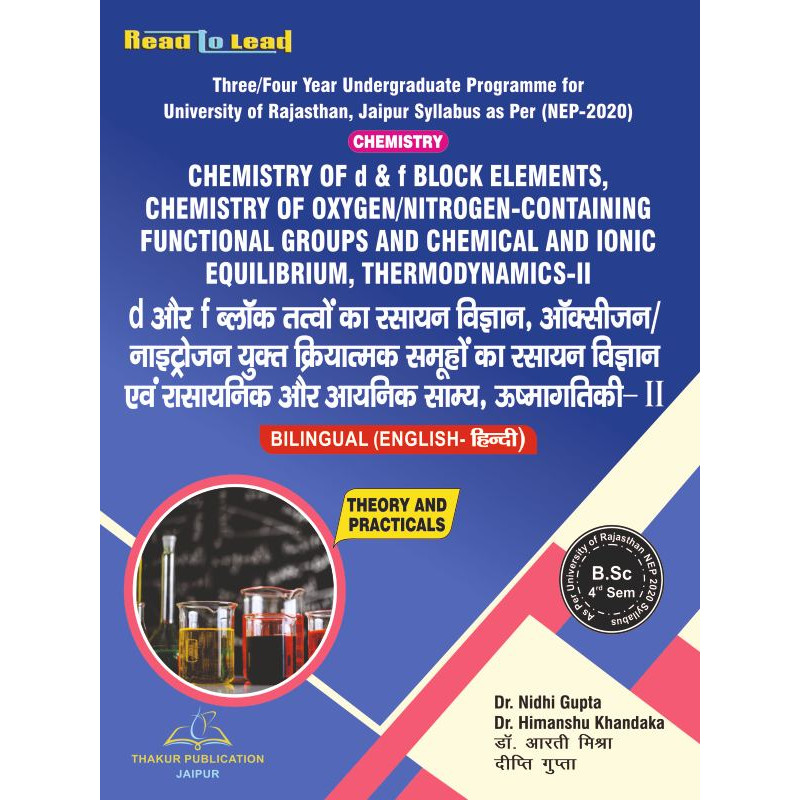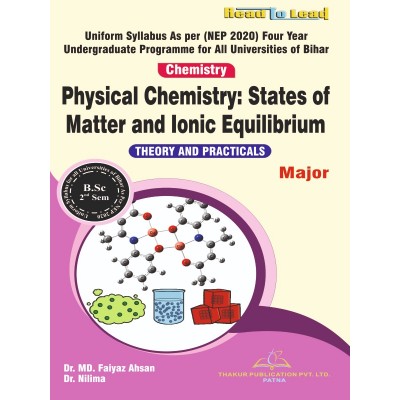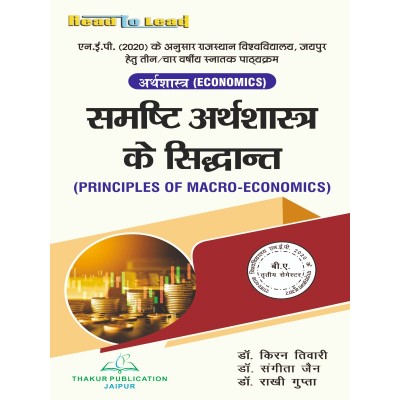Chemistry book University of Rajasthan B.Sc fourth Sem
AUTHORS : Dr. Nidhi Gupta, Dr. Himanshu Khandaka , Dr. Arti Mishra , Dipti Gupta
ISBN : 978-93-6180-876-0
Tax excluded
Syllabus ¼ikB~;Øe½
CHM-64T-203
Chemistry of d & f Block Elements, Chemistry of Oxygen/Nitrogen-Containing Functional Groups and Chemical and Ionic Equilibrium, Thermodynamics-II.
¼d vkSj f Cy‚d rRoksa dk jlk;u foKku] v‚Dlhtu@ukbVªkstu ;qDr dk;kZRed lewgksa dk jlk;u foKku ,oa jklk;fud vkSj vk;fud lkE;] Å"ekxfrdh& II½
|
Unit
|
Topic
|
Lecture
|
|
|
I
|
Chemistry of Elements of First Transition Series: Characteristic properties of d-block elements. Properties of the elements of the first transition series, their binary compounds and complexes illustrating relative stability of their oxidation-states, coordination number and geometry.
Chemistry of Elements of Second and Third Transition Series: General characteristics, comparative treatment with their 3d-analogues in respect of ionic radii, oxidation states, magnetic behaviour, spectral properties and stereochemistry.
Chemistry of Lanthanide and Actinide Elements: Electronic structure, oxidation states, ionic radii and lanthanide contraction, complex formation, occurrence and isolation, lanthanide compounds.
General features and chemistry of actinides, chemistry of separation of Np, Pu and Am from U, similarities between the later actinides and the later lanthanides. |
çFke laØe.k Js.kh ds rRoksa dk jlk;u foKku& d&Cy‚d rRoksa ds vfHkyk{kf.kd xq.k/keZA çFke laØe.k Js.kh ds rRoksa ds xq.k/keZ] muds f}vk/kkjh ;kSfxd vkSj ladqy tks mudh v‚Dlhdj.k&voLFkkvksa dh lkis{k fLFkjrk] milgla;kstd la[;k vkSj T;kfefr dks n'kkZrs gSaA
f}rh; vkSj r`rh; laØe.k Js.kh ds rRoksa dk jlk;u foKku& lkekU; fo’ks"krk,¡] vk;fud f=T;k ds laca/k esa muds 3d& vuq:i ds lkFk rqyukRed vfHkfØ;k] v‚Dlhdj.k voLFkk,¡] pqacdh; xq.k/keZ] LisDVªy xq.k vkSj f=foe jlk;uA
ySaFksukbM vkSj ,sfDVukbM rRoksa dk jlk;u& bysDVª‚fud lajpuk] v‚Dlhdj.k voLFkk,¡] vk;fud f=T;k vkSj ySaFksukbM ladqpu] ladqy cukuk] çkfIr LFkku vkSj i`FkDdj.k] ySaFksukbM ;kSfxdA
,sfDVukbM~l ds lkekU; xq.k/keZ vkSj jlk;u foKku] U ls Np, Pu vkSj Am ds i`FkDdj.k dk jlk;u] ckn ds ,sfDVukbM~l vkSj ckn ds ySaFksukbM~l ds chp lekurk,¡A |
15
|
|
II
|
Alcohols: Classification and nomenclature.
Monohydric alcohols - Methods of formation by reduction of aldehydes, ketones, carboxylic acids and esters. Hydrogen bonding, Acidic nature. Reactions of alcohol with mechanism.
Dihydric alcohols - methods of formation, chemical reactions of vicinal glycols, oxidative cleavage [Pb(OAc)4 and HIO4] and pinacol-pinacolone rearrangement.
Trihydric alcohols - methods of formation, chemical reactions of glycerol.
Phenols
Nomenclature, structure and bonding. Preparation of Phenols. Physical properties and acidic character. Comparative acidic strength of alcohols and phenols. Reactions of phenols- electrophilic aromatic substitution, acylation and carboxylation. Mechanisms of Fries rearrangement, Claisen rearrangement, Gattermann synthesis, Hauben-Hoesch reaction, Lederer-Manasse reaction and Reimer-Tiemann reaction.
Ethers and Epoxides
Methods of formation, physical properties. Chemical reactions - cleavage and autooxidation. Ziesel’s method.
Synthesis of epoxides. Acid and base-catalysed ring opening of epoxides, orientation of epoxide ring opening, reactions of Grignard and organolithium reagents with epoxides.
Aldehydes and Ketones
Structure of the carbonyl group. Synthesis of aldehydes from acid chlorides, synthesis of aldehydes and ketones using 1, 3-dithianes, synthesis of ketones from nitriles and from carboxylic acids. Physical properties.
Mechanism of nucleophilic additions to carbonyl group with particular emphasis on benzoin, aldol, Perkin and Knoevenagel condensations. Condensation with ammonia and its derivatives. Wittig reaction, Mannich reaction. Oxidation of aldehydes, Baeyer-Villiger oxidation of ketones, Cannizzaro reaction, MPV (Meervein-Pondrof-Verley), Clemmensen, Wolff-Kishner, LiAlH4 and NaBH4 reductions, Halogenation of enolizable ketones. Use of acetals and 1,3-dithiane as protecting group. |
,Ydksgy& oxhZdj.k vkSj ukedj.kA
eksuksgkbfMªd ,Ydksgy & ,fYMgkbM] dhVksu] dkcksZfDlfyd vEy vkSj ,LVj ds vip;u ls cuus dh fof/k;k¡A gkbMªkstu ca/k] vEyh; ç—frA fØ;kfof/k ds lkFk ,Ydksgy dh vfHkfØ;k,¡A
MkbgkbfMªd ,Ydksgy & cuus dh fof/k;k¡] fofluy XykbdkWy dh jklk;fud vfHkfØ;k,¡] v‚Dlhdj fonyu [Pb(OAc)4 vkSj HIO4]] vkSj fiukdkWy&fiukdksyksu iquO;ZoLFkkA
VªkbgkbfMªd ,Ydksgy & cukus dh fof/k;k¡] fXylj‚y dh jklk;fud vfHkfØ;k,¡A
fQuksy
ukedj.k] lajpuk vkSj ca/kA fQuksy dks cukukA HkkSfrd xq.k/keZ vkSj vEyh; xq.k/keZA ,Ydksgy vkSj fQuksy dh rqyukRed vEyh; lkUnzrkA fQuksy dh vfHkfØ;k,¡& bysDVªkWuLusgh ,sjkseSfVd çfrLFkkiu] ,sflyhdj.k vkSj dkcksZfDlyhdj.kA Ýkbt iquO;ZoLFkkiu] Dyslsu iquO;ZoLFkkiu] xkVjeSu la'ys"k.k] gkScsu&gks'k vfHkfØ;k] ysMjj&esukls vfHkfØ;k vkSj jhej&VheSu vfHkfØ;k ds fØ;kfof/kA
bZFkj vkSj ,ikWDlkbM~l
cukus dh fof/k;k¡] HkkSfrd xq.k/keZA jklk;fud vfHkfØ;k,¡ & fonyu vkSj Lor% v‚Dlhdj.kA thlsy fof/kA
,ikWDlkbM~l dk la'ys"k.kA ,ikWDlkbM~l ds vEy vkSj {kkj&mRçsfjr oy; dk [kqyuk] ,ikWDlkbM~l oy; ds [kqyus dk vfHkfoU;kl] fxzxukMZ vkSj v‚xsZuksfyfFk;e vfHkdeZdksa dh ,ikWDlkbM~l ds lkFk vfHkfØ;k,¡A
,fYMgkbM vkSj dhVksu
dkcksZfuy lewg dh lajpukA vEy DyksjkbM ls ,fYMgkbM dk la'ys"k.k] 1]3&MkbfFk,u dk mi;ksx djds ,fYMgkbM vkSj dhVksu dk la'ys"k.k] ukbVªkby vkSj dkcksZfDlfyd vEyksa ls dhVksu dk la'ys"k.kA HkkSfrd xq.k/keZA
csatksbu] ,YMksy] ifdZu vkSj uks,osutsy la?kuu ij fo'ks"k tksj nsus ds lkFk dkcksZfuy lewg esa ukfHkdLusgh ;ksxkRed dh fØ;kfof/kA veksfu;k vkSj mlds O;qRiUuksa ds lkFk la?kuuA fofVx vfHkfØ;k] eSfu’k vfHkfØ;kA ,YMhgkbM~l dk v‚Dlhdj.k] dhVksUl dk cs;j&foysxj v‚Dlhdj.k] dSfutkjks vfHkfØ;k] MPV ¼ehjokbu&ikWUMksQZ&osysZ½] Dysesalsu] oksYQ&fd'kuj] LiAlH4 vkSj NaBH4 vip;u] ,uksfytscy dhVksu dk gSykstuhdj.kA laj{k.k lewg ds :i esa ,lhVy vkSj 1]3&MkbfFk;su dk mi;ksxA |
15
|
|
III
|
Carboxylic Acids
Structure and bonding, physical properties, acidity of carboxylic acids, effects of substituents on acid strength. Preparation of carboxylic acids. Reactions of carboxylic acids, Hell-Volhard-Zelinsky reaction. Reduction of carboxylic acids, mechanism of decarboxylation.
Methods of formation and chemical reactions of halo acids. Hydroxy acids - malic, tartaric and citric acids.
Dicarboxylic acids: methods of formation and effect of heat and dehydrating agents (succinic, glutaric and adipic acids).
Carboxylic Acid Derivatives
Structure, nomenclature and synthesis of acid chlorides, esters, amides (urea) and acid anhydrides. Relative stability of acyl derivatives. Physical properties, interconversion of acid derivatives by nucleophilic acyl substitution.
Preparation of carboxylic acid derivatives, chemical reactions, mechanisms of esterification and hydrolysis (acidic and basic).
Organic Compounds of Nitrogen
Preparation of nitroalkanes and nitroarenes. Chemical reactions of nitroalkanes. Mechanisms of nucleophilic substitution in nitroarenes and their reductions in acidic, neutral and alkaline media. Picric acid.
Amines: Structure, nomenclature and preparation of alkyl, and aryl amines (reduction of nitro compounds, nitriles), reductive amination of aldehydic and ketonic compounds.
Physical properties, stereochemistry of amines. Separation of a mixture of primary, secondary and tertiary amines. Structural features effecting basicity of amines. Amine salts as phase-transfer catalysts. Gabriel-phthalimide reaction and Hoffmann bromamide reaction with mechanism.
Reactions of amines, electrophilic aromatic substitution in aryl amines, reactions of amines with nitrous acid. Diazotisation and mechanism. Synthetic transformations of aryl diazonium salts, azo coupling and its applications. |
dkcksZfDlfyd vEy
lajpuk vkSj ca/k] HkkSfrd xq.k/keZ] dkcksZfDlfyd vEy dh vEyrk] çfrLFkkfi;ksa ij vEy dk çHkkoA dkcksZfDlfyd vEy dks cukukA dkcksZfDlfyd vEy dh vfHkfØ;k,a] gsy&oksYgkMZ&tsfyaLdh vfHkfØ;kA dkcksZfDlfyd vEy dk vip;u] MhdkcksZfDlyhdj.k dh fØ;kfof/kA
gsyks vEy ds fuekZ.k vkSj jklk;fud vfHkfØ;kvksa dh fof/k;k¡A gkbMª‚Dlh vEy & eSfyd] VkVZfjd vkSj lkbfVªd vEyA
MkbdkcksZfDlfyd vEy& Å"ek vkSj futZyhdj.k dkjdksa ¼lfDlfud] XywVsfjd vkSj ,fMfid vEy½ ds fuekZ.k vkSj çHkko dh fof/k;k¡A
dkcksZfDlfyd vEy O;qRiUu
vEy DyksjkbM] ,LVj] ,ekbM ¼;wfj;k½ vkSj vEy ,ugkbMªkbM dh lajpuk] ukedj.k vkSj la'ys"k.kA ,fly O;qRiUu dh lkis{k fLFkjrkA HkkSfrd xq.k/keZ] ukfHkdLusgh ,fly çfrLFkkiu }kjk vEy O;qRiUu dk varj:ikarj.kA
dkcksZfDlfyd vEy O;qRiUuksa dks cukuk] jklk;fud vfHkfØ;k,¡] ,LVjhdj.k vkSj ty vi?kVu dh fØ;kfof/kA ¼vEyh; vkSj {kkjh;½A
ukbVªkstu ds dkcZfud ;kSfxd
ukbVªks,Ydsu vkSj ukbVªks,jhu dks cukukA ukbVªks,Ydsu dh jklk;fud vfHkfØ;k,¡A ukbVªks,jhu esa ukfHkdLusgh çfrLFkkiu dh fØ;kfof/k vkSj vEyh;] mnklhu vkSj {kkjh; ek/;eksa esa mudk vip;uA fifØd vEyA
,sehUl& ,sfYdy vkSj ,fjy ,sehUl dh lajpuk] ukedj.k vkSj cukuk ¼ukbVªks ;kSfxdksa] ukbVªkby dk vip;u½] ,fYMgkbM vkSj dhVksfud ;kSfxdksa dk vip;ukRed ,sehuhdj.kA
HkkSfrd xq.k/keZ] ,sehu dk f=foe jlk;u çkFkfed] f}rh;d vkSj r`rh;d ,sehu ds feJ.k dk i`FkDdj.kA ,sehu dh vEyrk dks çHkkfor djus okyh lajpukRed fo'ks"krk,¡A pj.k&LFkkukarj.k mRçsjd ds :i esa ,sehu yo.kA xSfcz;y&FkSfyekbM vfHkfØ;k vkSj g‚QeSu czksekekbM vfHkfØ;k fØ;kfof/k ds lkFkA
,sehuksa dh vfHkfØ;k,¡] ,fjy ,sehuksa esa bysDVªkWuLusgh ,sjkseSfVd çfrLFkkiu] ukbVªl vEy ds lkFk ,sehuksa dh vfHkfØ;k,¡A Mkb,tksVkbts'ku vkSj fØ;kfof/kA ,fjy Mkb,tksfu;e yo.kksa dk la’ysf"kr :ikarj.k] ,tks ;qXeu vkSj blds vuqç;ksxA |
15
|
|
IV
|
Thermodynamics –II
Second Law of Thermodynamics: Need for the law, different statements of the law. Carnot cycle and its efficiency, Carnot-Theorem. Thermodynamic scale of temperature.
Concept of Entropy: Entropy as a state function, entropy as a function of V&T, entropy as a function of P&T, entropy change in physical change, Clausius inequality and entropy as a criteria of spontaneity and equilibrium. Entropy changes in ideal gases and mixing of gases.
Third Law of Thermodynamics: Nernst heat theorem, statement and concept of residual entropy, evaluation of absolute entropy from heat capacity data. Gibbs and Helmholtz functions: Gibbs function (G) and Helmholtz function (A) as: thermodynamic quantities. A & G as criteria for thermodynamic equilibrium and spontaneity, their advantage over entropy change. Variation of G and A with P, V and T.
Chemical Equilibrium:
Equilibrium constant and free energy. Thermodynamic derivation of law of mass action. Le Chatelier’s principle. Reaction Isotherm and reaction isochore. Clapeyron equation and Clausius-Clapeyron equation, applications.
Ionic Equilibrium: Strong, moderate and weak electrolytes, degree of ionisation, factors affecting degree of ionisation, ionisation constant and ionic product of water. Ionisation of weak acids and bases, pH scale,common ion effect. Salt hydrolysis – calculation of hydrolysis constant, degree of hydrolysis and pH for different salts. Buffer solutions. Solubility and solubility product.
|
Å"ekxfrdh& II
Å"ekxfrdh dk f}rh; fu;e& fu;e dh vko';drk] fu;e ds fofHkUu dFkuA dkuksZV pØ vkSj bldh n{krk] dkuksZV&çes;A rkieku dk Å"ekxfrdh iSekukA
,UVª‚ih dh vo/kkj.kk& ,d voLFkk Qyu ds :i esa ,UVª‚ih] V&T ds Qyu ds :i esa ,UVª‚ih] P&T ds Qyu ds :i esa ,UVª‚ih] HkkSfrd ifjorZu esa ,UVª‚ih ifjorZu] Dy‚fl;l vlekurk vkSj Lor% vkSj lkE; ds ekunaM ds :i esa ,UVª‚ihA vkn'kZ xSlksa esa ,UVª‚ih ifjorZu vkSj xSlksa dk feJ.kA
Å"ekxfrdh dk r`rh; fu;e& uuZLV Å"ek çes;] vof'k"V ,UVª‚ih dk dFku vkSj vo/kkj.kk] Å"ek/kkfjrk MsVk ls fujis{k ,UVª‚ih dk vk¡dyuA fxCl vkSj gsYegksYV~t Qyu& fxCl Qyu (G) vkSj gsYegksYV~t Qyu (A) ds :i esa& Å"ekxfrd jkf’k;k¡A Å"ekxfrd lkE; vkSj Lor% ds fy, ekunaM ds :i esa A vkSj G] ,UVª‚ih ifjorZu ij mudk ykHkA P, V vkSj T ds lkFk G vkSj A dk ifjorZuA
jklk;fud lkE;&
lkE; fLFkjkad vkSj eqDr ÅtkZA æO; vuqikrh fØ;k ds fu;e dh Å"ekxfrd O;qRifÙkA yk 'kkrSfy, ds vuqç;ksxA vfHkfØ;k lerkih vkSj vfHkfØ;k levk;rfudA DySisj‚u lehdj.k vkSj Dy‚fl;l&DySisj‚u lehdj.k] vuqç;ksxA
vk;fud lkE;& Ácy] e/;e vkSj nqcZy fo|qr vi?kV~;] vk;uhdj.k dh fMxzh] vk;uhdj.k dh fMxzh dks çHkkfor djus okys dkjd] vk;uhdj.k fLFkjkad vkSj ty dk vk;fud xq.kuQyA ncZy vEyksa vkSj {kkjksa dk vk;uhdj.k] pH Ldsy] le&vk;u çHkkoA yo.k dk tyvi?kVu& fofHkUu yo.kksa ds fy, tyvi?kVu fLFkjkad] tyvi?kVukad vkSj pH dh x.kukA cQj foy;uA foys;rk vkSj foys;rk xq.kuQyA |
15
|
|
|
Practical ¼ç;ksxkRed½
|
|
|
|
Topic
|
fo"k;
|
Marks
|
|
|
Inorganic Chemistry Inorganic Preparations
a) Preparation of tetraamminecopper(II) sulphate b) Preparation of cis and trans-potassium diaquadioxalatochromate(III). c) Synthesis of sodium trioxalatoferrate(III). d) Preparation of bis(glyoxamato)nickel (II).
|
vdkcZfud jlk;u
vdkcZfud rS;kjh
a) VsVªk,sehud‚ij (II) lYQsV dh rS;kjh
b) fll vkSj Vªkal&iksVSf'k;e Mkb,DokMkbvkWDtsysVks (III) dh rS;kjhA
c) lksfM;e Vªkbv‚DtsySVksQsjsV (III) dk la'ys"k.kA
d) fcl ¼Xyk;ksvkWDlkesVks½ fufdy (II) dh rS;kjhA
|
10
|
|
|
Organic Chemistry a) Organic Syntheses b) Synthesis of iodoform from ethanol and acetone (Aliphatic Electrophilic Substitution). c) Synthesis of aspirin from salicylic acid (Acetylation). d) Synthesis of phthalimide from phthalic anhydride. e) Synthesis of succinic anhydride.
|
dkcZfud jlk;u dkcZfud la'ys"k.k a) bFksu‚y vkSj ,lhVksu ¼,sfyQSfVd fo|qrLusgh çfrLFkkiu½ ls vk;ksMksQ‚eZ dk la'ys"k.kA b) lSfyflfyd vEy ¼,flfVyhdj.k½ ls ,fLifju dk la'ys"k.kA c) FkSfyd ,ugkbMªkbM ls FkSyhekbM dk la'ys"k.kA d) lfDlfud ,ugkbMªkbM dk la'ys"k.kA
|
10
|
|
|
Physical Chemistry
Transition Temperature
a) Determination of transition temperature of the given substance (Na2SO4.10H2O, MnCl2.4H2O or SrBr2.6H2O) by thermometric method.
Phase Equilibrium
a) To construct the phase diagram of two component system like phenol-H2O system and determine the CST (critical solution temperature) and composition of the solution at CST. b) To study the effect of solute NaCl and succinic acid etc. on the CST (critical solution temperature) of two partially miscible liquids (phenol-H2O system) and determine the concentration of that solute in the given partially miscible liquid system.
Ionic Equilibrium
Preparation of different types of buffer solutions and determination of pH using pH meter. |
HkkSfrd jlk;u
laØe.k rkieku
a) fn, x, inkFkZ ¼Na2SO4.10H2O, MnCl2.4H2O ;k SrBr2.6H2O½ ds laØe.k rki dk fu/kkZj.k FkeksZesfVªd fof/k }kjkA
ÁkoLFkk lkE;
a) fQuksy& H2O ra= tSls nks ?kVd ra= ds ÁkoLFkk vkjs[k dk fuekZ.k djuk vkSj CST ¼Økafrd foy;u rkieku½ vkSj CST ij foy;u dk la?kVu fu/kkZfjr djukA b) nks vkaf'kd :i ls feJ.kh; æo inkFkksaZ ¼fQuksy&H2O ra=½ ds CST ¼Økafrd foy;u rkieku½ ij foys; NaCl vkSj lfDlfud vEy vkfn ds çHkko dk v/;;u djuk vkSj fn, x, vkaf'kd :i ls feJ.kh; æo ra= esa ml foys; dh lkaærk fu/kkZfjr djukA
vk;fud lkE;
fofHkUu çdkj ds cQj foy;uksa dh rS;kjh vkSj pH ehVj dk mi;ksx djds pH dk fu/kkZj.kA |
10
|
|

























